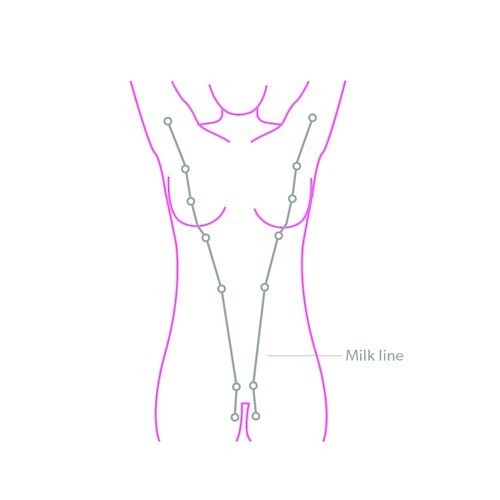Nipple discharge
Up to 20% of women are able to express fluid from their nipples. Benign discharge doesn’t usually happen by itself, but only occurs when the nipples are squeezed. It tends to be from both breasts and come from multiple ducts, and is often creamy, brown or green. Any discharge which occurs without squeezing, comes from a single duct in the nipple and is clear or bloodstained needs to be looked at by a health professional.
Galactorrhoea is a milky discharge which is not associated with breastfeeding. It is usually caused by an overproduction of prolactin, the hormone that is responsible for milk production. This can be the result of certain medications (some sedatives, antipsychotics or antidepressants), excessive breast stimulation, or disorders of the pituitary gland. Blood tests should be ordered by your GP to check your prolactin, thyroid levels and kidney function.
Nipple/areola eczema
Eczema on the nipple-areola complex usually starts on the areola, and sometimes spreads to involve the nipple. Treatment with topical corticosteroid creams is usually successful but if treatment is not working and the 'eczema' on the nipple persists or worsens, a referral to a breast clinic for a biopsy is required, to exclude Paget’s Disease, a rare type of breast cancer.
Gynaecomastia - men
This benign condition is characterised by an overgrowth of glandular tissues in the male breast, sometimes causing discomfort. It is usually the result of a hormone imbalance and is mostly seen in males at infancy, puberty and in mid-to-later life. The condition is common, affecting 50-70% of men and often goes away without any intervention.
Older men produce less testosterone, and those with excess body fat produce more oestrogen, which causes growth of breast glandular tissue. Teenage boys may have a degree of gynaecomastia during puberty, which usually resolves as hormone levels stabilise. Medical assessment of gynaecomastia is important in order to establish the cause as it may be due to an underlying medical condition.
Gynaecomastia should not be confused with pseudo-gynaecomastia which is seen in overweight men who have increased fat deposits in their breasts (man-breasts).
Accessory nipples or breast tissue

This is a condition you are born with. The accessory nipple develops from left over fetal breast tissue, from embryonic development and can occur in both women and men. In about 5% of the population an extra nipple develops. Usually it is seen on the lower part of the breast but may occur anywhere along the embryonic milk lines. Often, they are small and may be mistaken for moles. They are usually surgically removed for cosmetic reasons or because of ulceration or another clinical concern.
Accessory breast tissue is a prominent swelling that contains extra breast tissue, often in the underarm area, but more than one site may be affected. As the tissue contains all the elements of normal breast tissue it is subject to hormonal influences, so may be noticed during puberty, pregnancy or lactation. All diseases of the breast, both benign and cancerous, can occur in accessory breast tissue. Surgical excision with or without liposuction of the tissue is an option for large problematic areas, but most cases are so small patients are unaware of their presence.
